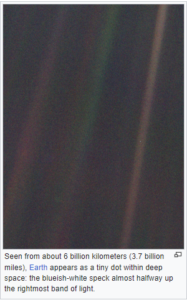Introduction:
Science in my classroom is about providing students with the tools necessary to decode and appreciate the world around them.
The Pale Blue Dot Image:

The most unassuming way to achieve this is to introduce them to the revered, The Pale Blue Dot. This image doesn’t seem like much, does it? You may be thinking someone must have snapped this picture while the lens cap was still on. But if you take another look, about halfway down towards your Centre. There is a small dot, no brighter than its surroundings. It’s not a speck of dust or a smudge on the camera lens. It’s us! It’s all of us! It’s the Earth!
Voyager 1 Space Probe:
On Valentine’s Day 1990, Voyager 1 Space Probe took this iconic image. This year we celebrate its 31st anniversary. The probe was designed to take pictures of the furthest regions of our solar system. In fact, as it stands today, Voyager is the farthest human-made object from the Sun.
Carl Sagan’s Influence:
In 1990, 14 years after its primary mission and before most of my students were even born, it found itself an amazing 3.7 billion miles from Earth. Carl Sagan, the famous astronomer and one of my favorite scientists of all time suggested the idea of turning the spacecraft around and taking one last image of the Earth. This image would not be for scientific reasons, as the Earth would appear too small for any detail to be made out, but such an image might be useful as a perspective on our place in the Universe.
Many Scientists in NASA’s Voyager program disagreed. They were worried that taking an image of Earth so close to the Sun would further damage the spacecraft’s camera system. It was already suffering from minor power failure and equipment damage.
However, months later, finally, Carl Sagan’s request was granted. Sixty ultra-high-resolution images were snapped and one of them was rightly named, “The Pale Blue Dot.” This was the Earth, defenseless, irrelevant and precious, seen as no human had ever seen it before.
Carl Sagan, wrote a book inspired by the photo, called the Pale Blue Dot. Below is an extract from his book.
“Look again at that dot. That’s here. That’s home. That’s us. On it everyone you love, everyone you know, everyone you ever heard of, every human being who ever was, lived out their lives. The aggregate of our joy and suffering, thousands of confident religions, ideologies, and economic doctrines, every hunter and forager, every hero and coward, every creator and destroyer of civilization, every king and peasant, every young couple in love, every mother and father, hopeful child, inventor and explorer, every teacher of morals, every corrupt politician, every ‘superstar,’ every ‘supreme leader,’ every saint and sinner in the history of our species lived there on a mote of dust suspended in a sunbeam.
Even the complex tapestry of morality, with its teachers and seekers, is woven into the fabric of that tiny, vulnerable mote of dust. In its cosmic isolation, the Pale Blue Dot strips away the illusions of grandeur, laying bare the shared humanity of every corrupt politician and virtuous leader, every ‘superstar’ and ‘supreme leader,’ every saint and sinner throughout the annals of our species.
Carl Sagan’s poetic reflection beckons us to contemplate not just the fragility of our planet but the unity of our human experience. It’s a call to transcend the superficial differences that often divide us and to recognize the shared journey we undertake on this cosmic voyage. The Pale Blue Dot, though seemingly insignificant in the vastness of space, becomes a profound symbol of our interconnectedness and collective responsibility.”
Conclusion:
In my classroom, at Discover Learning, Motor City, Dubai. The Pale Blue Dot aims to persuade students to think differently about the Earth. It provokes thinking, encourages discussion and promotes the appreciation of science .

